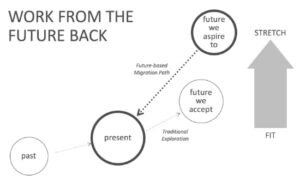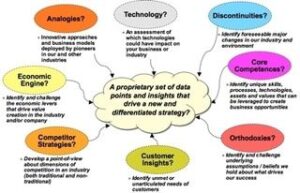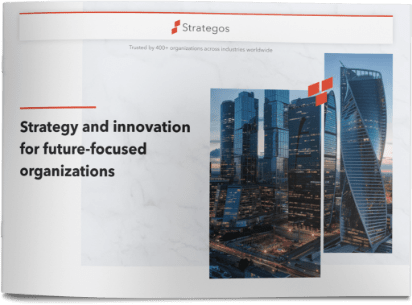Well it may come as a surprise but yes some professional services firms do have principles, in fact at Strategos we pride ourselves on not just being principled in the way we work with clients but we also operate our client engagements on a set of clear principles.
We believe in a few simple but important principles that underpin our innovation methodologies, tools and techniques.

Innovation principles last longer than methods and approaches; principles are guides that allow us to evolve methods and improve and adapt them to client situations.
Whether we are working with clients to help them deveIop a new innovation strategy or working on specific innovation challenges the above principles apply.
In this blog we look at the first three inform principles in more detail.
Principle #1:
Work from the future back to aim innovation
 Our work with clients over nearly 20 years has taught us that the best strategies are those that can be translated into a tangible roadmap or migration map that shows what we need to do to get from where we are now to where we want to be.
Our work with clients over nearly 20 years has taught us that the best strategies are those that can be translated into a tangible roadmap or migration map that shows what we need to do to get from where we are now to where we want to be.
Additionally our experience tells us that strategic aiming, making choices about where we will focus, increases innovation success. Creativity within constraints works better than absolute freedom, leading to ideas that relate to each other and drive conversations about how small ideas in a given focus area or domain can be linked to create bigger results.
We believe that the first step in any innovation process should be aiming as this allows the search for new perspectives to be directed and the process of developing key insights to be clearly focused.
Principle #2:
Listen to new voices and build new perspectives.
 We believe that building a broad enough set of new perspectives to drive new thinking can only come about through a multi-lens approach. We further believe that a new and differentiated strategy or concept can only come from a proprietary set of insights. These insights are built by working with up to 8 different lenses. Each client engagement / innovation challenge requires a focus on a sub-set of lenses that provide just the right amount and diversity of insights required. These lenses allow us to look at the world in a different way and gain unique insights e.g. orthodoxies are widely held beliefs, but when challenged can lead to big new opportunities and new ways of doing business; an understanding of discontinuities in the external environment that can lead to different business practices; and the use of analogies can facilitate the transfer of great ideas/practices/technologies in one industry to a completely different industry.
We believe that building a broad enough set of new perspectives to drive new thinking can only come about through a multi-lens approach. We further believe that a new and differentiated strategy or concept can only come from a proprietary set of insights. These insights are built by working with up to 8 different lenses. Each client engagement / innovation challenge requires a focus on a sub-set of lenses that provide just the right amount and diversity of insights required. These lenses allow us to look at the world in a different way and gain unique insights e.g. orthodoxies are widely held beliefs, but when challenged can lead to big new opportunities and new ways of doing business; an understanding of discontinuities in the external environment that can lead to different business practices; and the use of analogies can facilitate the transfer of great ideas/practices/technologies in one industry to a completely different industry.
This multi-lens perspective takes us past the somewhat limited customer insight only approach and builds a richness of inputs that leads to better and more diverse outputs.
An additional consequence of this principle is that we seek to gain insights from a diverse range of people from as many levels as possible in the organisation; from both inside and outside; from related and non-related industries.
Principle #3:
Diverge and then converge.
 What we see in many organisations is that they are understandably very keen to get to a result, to an outcome. They want to jump to answers and conclusions too soon. That desire for speed can often times lead to an outcome that is not sufficiently different and differentiated to succeed.
What we see in many organisations is that they are understandably very keen to get to a result, to an outcome. They want to jump to answers and conclusions too soon. That desire for speed can often times lead to an outcome that is not sufficiently different and differentiated to succeed.
We believe that at all stages of the innovation and strategy process it is important to take time to allow for divergent thinking but also to ensure that at key points in the process we converge to a shared point of view that we use as the input for the next stage.
We believe, as stressed in Principle #2, that it is crucially important to build a broad and deep set of new perspectives. But in order to use these new perspectives in a meaningful way we seek to converge to a tightly constructed set of key insights that can guide the opportunity development phase.
The process of synthesising such a broad set of new perspectives can be difficult and time consuming but our experience tells us that it is well worth the effort.
These principles have been proven over the many years we have helped clients. While we often adapt our methods and tools to reflect a specific client situation we know as long as they hold true to the underlying principle we continue to deliver results.
We will examine the principles that underpin the execution and embedding of innovation in future blogs.





